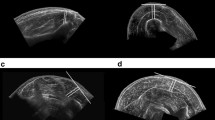Summary
Cross-sectional images of the anterior tibial muscle group were obtained using real-time ultrasound scanning in 17 normal women. From photographs taken of the images, the cross-sectional area (CSA) and two linear measurements of muscle cross-section were determined. A measurement of the shortest distance of the muscle depth was termed DS, and a measurement of the longest distance through the muscle group was termed DL. Both linear dimensions showed a positive correlation with CSA and the best correlations were obtained when the dimensions were squared or combined (DS × DL). The correlation values were: CSA vs DS2, r=0.9; CSA vs DL2, r=0.75 and CSA vs DS × DL, r=0.88. An approximate value for CSA could be calculated from DS2 by the equation 2 × DS2 + 1. A shape ratio, obtained by dividing DL by DS, was consistent within the group [mean 2.1 (SD 0.2)] and characterised the muscle geometrically. The CSA of repeated scans was assessed for repeatability between-days and between-scans by analysis of variance and the coefficient of variation (CV) calculated. Areas were repeatable between-days (CV 6.5%) and between-scans (CV 3.6%). Linear dimensions of the anterior tibial muscle group reflected CSA and their potential for assessing changes in muscle size with atrophy and hypertrophy have yet to be established.
Similar content being viewed by others
References
Brahim F, Zaccardelli W (1986) Ultrasound measurements of the anterior leg compartment. Am J Sports Med 14:300–302
Dietrichson P, Coakley J, Smith PEM, Griffiths RD, Helliwell T, Edwards RHT (1987) Conchotome and needle percutaneous biopsy of skeletal muscle. J Neurol Neurosurg Psychiatry 50:1461–1467
Doxey GE (1987) Assessing quadriceps femoris muscle bulk with girth measurements in subjects with patello-femoral pain. J Orthop Sports Phys Ther 9:177–183
Gershuni DH, Gosink BB, Hargens AR, Gould RN, Forsythe JR, Mubarak SJ, Akeson WH (1982) Ultrasound evaluation of the anterior musculofascial compartment of the leg following exercise. Clin Orthop Relat Res 167:185–190
Heckmatt JZ, Pier N, Dubowitz V (1988a) Measurement of quadriceps muscle thickness and subcutaneous tissue thickness in normal children by real-time imaging. J Clin Ultrasound 16:171–176
Heckmatt JZ, Pier N, Dubowitz V (1988b) Assessment of quadriceps femoris muscle atrophy and hypertrophy in neuromuscular disease in children. J Clin Ultrasound 16:177–181
Loo A, Stokes MJ (1990) Diagnostic ultrasound scanning for clinical measurement of quadriceps muscle size and estimation of strength. Proceedings of the 3rd International Physiotherapy Congress. Link Printing Pty Lrd, Sydney, pp 655–660
Lunt RM (1978) Handbook of ultrasound B-scanning in medicine. Cambridge University Press, Cambridge
Maughan RJ, Watson JS, Weir J (1983) Strength and cross-sectional area of human skeletal muscle. J Physiol 338:37–40
Stewart HF, Moore RM (1984) Development of health risk evaluation data for diagnostic ultrasound: a historical perspective. J Clin Ultrasound 12:493–500
Stokes M (1985) Reliability and repeatability of methods of measuring muscle in physiotherapy. Physiother Pract 1:71–76
Stokes M, Young A (1985) Measurement of quadriceps wasting by real-time ultrasonography. Int J Rehabil Res [Suppl 4] 8:22
Stokes M, Young A (1986) Measurement of quadriceps cross-sectional area by ultrasonography: a description of the technique and its applications in physiotherapy. Physiother Pract 2:31–36
Warwick R, Williams P (1973) Gray's anatomy. Warwick R, Wiliams P (eds) 37th edn. Longman, Edinburgh
Weiss LW, Clark FC (1985) Ultrasonic protocols for separately measuring subcutaneous fat and skeletal muscle thickness in the calf area. Phys Ther 65:477–481
Weiss LW, Clark FC, Harvard DG (1988) Effects of heavy resistance triceps surae muscle training on strength and muscularity of men and women. Phys Ther 68:208–213
Young A, Hughes I, Russell P, Parker MJ, Nicols PJR (1980) Measurement of quadriceps muscle wasting by ultrasonography. Rheumatol Rehabil 19:141–148
Young A, Stokes M, Crowe M (1984) Size and strength of the quadriceps muscles of old and young women. Eur J Clin Invest 14:282–287
Young A, Stokes M, Crowe M (1985) The size and strength of the quadriceps muscles of old and young men. Clin Physiol 5:145–154
Author information
Authors and Affiliations
Rights and permissions
About this article
Cite this article
Martinson, H., Stokes, M.J. Measurement of anterior tibial muscle size using real-time ultrasound imaging. Eur J Appl Physiol 63, 250–254 (1991). https://doi.org/10.1007/BF00233856
Accepted:
Issue Date:
DOI: https://doi.org/10.1007/BF00233856




